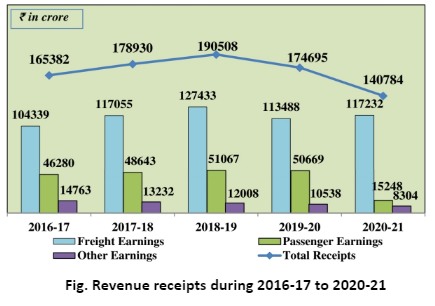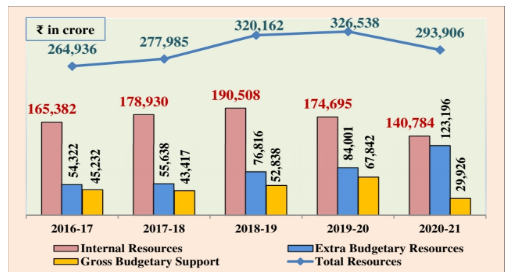Context:
- The Union Cabinet has approved proposals worth approximately 32,512 crore from the Ministry of Railways to expand the rail network in various parts of India. The Standing Committee on Railways and CAG report have provided insights into the state of finances of the railways sector.
More about the news:
- The funds will be allocated to states like Uttar Pradesh, Bihar, Maharashtra, Gujarat, and Odisha.
- Recent reports shed light on the operational deficiencies of the Indian Railways.
Report from Standing Committee on Railways:
- Financial assistance for pension expenses: It has restated its recommendation for railways to seek partial financial assistance from the Ministry of Finance to address pension requirements.
- Increasing Pension obligations: It is projected to keep growing, presenting challenges for the railways. Estimated pension liabilities have risen from approximately 17,000 crore in 2011-12 to an expected payout of about 60,000 crore in 2023-24.
- Long-term sustainability: While addressing these financial needs would naturally impact railway operations, the larger concern remains the long-term sustainability.
- Operational Deficiencies: The consistent decline in self-generated funds of railways indicates internal deficiencies in the overall planning and management of the Indian Railways.

Report by the Comptroller and Auditor General (CAG) of India for 2021-22:
- Deterioration in Operating ratio (OR): The OR is a measure to calculate the ratio of working expenses to traffic earnings. It was 107.39 per cent in 2021-22 against 97.45 per cent in 2020-21 as the railways could not generate a net surplus.
- OR not reflecting true financial performance: If the actual expenditure on pension payments as well as expenditure on the Depreciation Reserve Fund (DRF) is taken into account, the OR would have been higher, at 109.36 per cent.
- DRF is maintained for replacement and renewal of old assets.
- Inadequate DRF Provision: It has steadily decreased in the past five years. It hindered the replacement of aging assets as well as posed serious risks to operational safety.
- Ordinary Working Expenditure (OWE): During 2020-21, OWE increased to 98.27 per cent of the total revenue expenditure as compared to the average of 75.45 per cent during the past five years.
- Ordinary Working Expenditure (OWE) comprises expenditure on day-to-day maintenance and operations of the Railways.
- Inadequate generation of internal resources: It resulted in greater dependence on Gross Budgetary Support (GBS) and Extra Budgetary Resources (EBR).
- During 2020-21, railways generated total internal resources of ₹ 1,40,783.55 crore against ₹ 2,25,913 crore envisaged in the budget estimates.
- The amount of EBR was ₹71,065.86 crore, which represented a decrease of 42.31% as compared with 2020-21.
- The Indian Railways(IR) have been raising EBR through Indian Railway Finance Corporation (IRFC), since its inception in 1987, for procurement of rolling stock.

Fig. Share of various resources of IR during last five years
- IRFC is a Schedule ‘A’ Public Sector Enterprise under the administrative control of the Ministry of Railways, Govt. of India.
- The primary objective of IRFC is to meet the predominant portion of EBR requirement of the Indian Railways through market borrowings at the most competitive rates and terms.
|
- Challenge of Cross-subsidisation: IR was unable to meet its operational cost of passenger services and other coaching services.
-
- Passenger fares are cross-subsidised using profits generated on freight operations. This cross-subsidisation continues to be a concern, as railways have not been able to raise fares in the sleeper class.
- In FY22, the railways’ loss decreased over the previous year but the entire profit of ₹36,196 crore from freight traffic was utilized to cross-subsidise and compensate the loss on operation of passenger and other coach services.
About Railway Sector in India:
- India has the 4th largest railway system in the world, behind only the US, Russia and China.
- The Indian Railways consists of a total track length of 126,366 km with 7,335 stations. 5243 km of track length was achieved during 2022-23 as compared to 2909 Kms during 2021-22.
- Average daily track laying was 14.4 kms per day (highest-ever commissioning).
- Indian Railways is the single largest employer in India and the eighth largest in the world, employing approximately 1.3 Mn people.
|
Challenges faced by railway sector in India:
- Security Issues: The presence of technical malfunctions and system breakdowns leads to signaling inaccuracies, track misplacements, and other severe safety risks. Example-Balasore train incident.
- Departmentalization of the railway board: It is structured into distinct divisions such as mechanical, electrical, traffic, and finance, etc. making it an intricate, excessively departmentalized entity causing inefficiencies in the decision-making process.
- Burden of Social obligations: It is tasked with fulfilling dual roles of generating revenue and fulfilling social obligations. It is seen as a commercial entity as well as obligated to meet societal commitments.
- Over Congestion: It results in crowded trains and heightened risks. The passenger load and insufficient capacity utilization undermines safety measures and presents difficulties in handling passenger movement during emergency situations.
- Lack of modernisation: It has failed to modernize its infrastructure and services. Its equipment, procedures, and training have persisted without substantial changes over the years.
- As per CAG’s analysis of railway accidents that took place between 2017 and 2021, . the train derailments persist as the primary cause of accidents, responsible for over 69% of the total incidents.
- Land acquisition: Delays in land acquisition leads to project delays and increased project costs.
- Regulatory Hurdles: The projects assigned by the government for the enhancement and modernization of the railway system encounter delays due to bureaucratic obstacles, corruption, and environmental considerations.
- High freight cost: India’s freight cost is 13 to 14 percent of GDP, whereas it is 9 to 10 percent of GDP in other developed countries,
- Absence of public-private collaborations: Private investment currently comprises merely around 15% of the overall infrastructure investment.
Government Reforms in Railway Sector:
| Vision 2024 |
- It has been envisaged to achieve targets of 2024 MT freight loading by 2024.
|
| 100% Electrification |
- Indian Railways (IR) is rapidly progressing to accomplish Mission 100% Electrification and become the largest green railway network in the world.
- It aims to electrify the entire network by 2023 which will lead to annual energy savings of $1.55 Bn.
- As of Feb 2023, 85% of the total Broad-Gauge network has been electrified.
|
| Kavach System |
- It is an automatic train protection system indigenously developed by Indian Railways.
|
| High speed rails |
- 400 new generation Vande Bharat Trains to be manufactured during the next three years.
|
| Multimodal logistics |
- 100 PM Gati Shakti Cargo terminals for multimodal logistics to be developed during the next three years.
|
| National Rail Plan: |
- It aims to increase the share of freight traffic from current 27% to 45% by 2030.
|
| Mission Raftaar |
- It aims to achieve speed enhancement, doubling average speed of freight trains and increasing the average speed of Superfast /mail/Express trains.
|
Way Forward:
- Enhancing financial sustainability: Despite increased investments through the Union Budget, proper financial management is necessary for the railways to reach its potential in capacity creation and modernization.
- Exploring means of Revenue generation: While enhancing operational efficiency is crucial, the government needs to determine its approach to managing the railways.
- Acknowledging the management responsibility: State of railway finances isn’t solely the railway’s responsibility. For example, the railway has limited control over passenger fares in terms of revenue, and wages and pensions on the expenditure side.
- Diversification of freight basket: It needs to take steps to diversify its freight basket to enhance freight earnings.
- Currently, transportation of coal constitutes about 46 per cent of its freight earnings.
- Renewal of Over aged assets: There is a huge backlog of renewal and replacement of over-aged assets, which needs to be replaced timely, for safe running of trains.
- Ensuring private participation: To sustain investments in India’s infrastructure environment, social acceptance and enforcement of user-pays principle as well as stricter contract enforcement will be required.
- Streamlining regulatory hurdles: The government should focus on streamlining the land acquisition process, guaranteeing equitable compensation, and providing proper rehabilitation for affected individuals.
- Minimization of operational losses: Thorough review of passenger operations as well as the implementation of necessary measures to minimize losses are needed.
- Efficient utilisation of Rashtriya Rail Sanraksha Kosh funds(RKSK): As per the CAG report, the usage of these funds for non-priority areas and non-safety works went up in several zones to as much as 25%.
- RKSK was introduced for renewal, replacement, and upgradation of railway safety assets.
- Out of 1127 derailments during 2017-21, 289 derailments (26%) were linked to track renewals and the major reason was non-utilisation of RKSK funds.
Source: Business Standard
![]() 18 Aug 2023
18 Aug 2023


